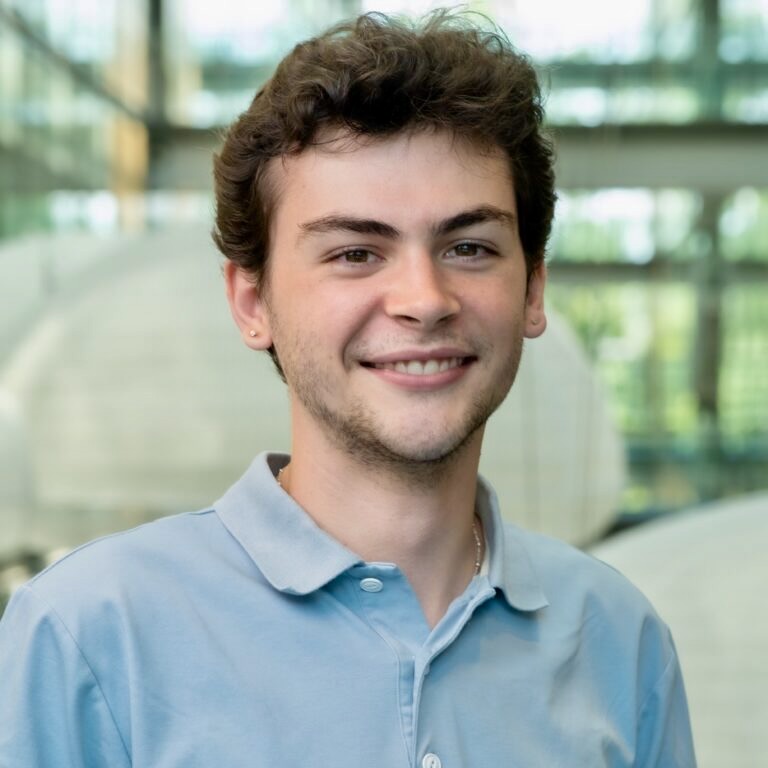In partnership with the DOD: Weichman Lab explores strong light-matter coupling

In Princeton’s Micro/Nano Fabrication Center, a state-of-the-art cleanroom here on campus, Weichman Lab grad student Alexander McKillop is intent on spectroscopy. He fabricates his own nanostructures. Makes his own mirrors. Lays down his own thin films … all in service of expanding our knowledge of something that nature has done seamlessly throughout the eons (or else life would not exist): manipulating the behavior of molecules using light.
Since the Weichman Lab opened five years ago, it has added steadily to this knowledge base through the study of polaritons, hybrid quasiparticles that are the product of strong interactions between light and matter. So far, the lab has been employing infrared light to couple to the vibrational motion of molecules confined in an optical cavity.
Their goal—a longstanding “Holy Grail” of chemical physics—is to use that light to shape and manipulate molecular behavior.
Now, the U.S. Department of Defense (DOD) Air Force Office of Scientific Research (AFOSR) is driving a new direction for the young lab in which McKillop’s optical instruments will be used to study light-matter coupling employing visible light.
Assistant Professor of Chemistry Marissa Weichman said this work would not be possible without the DOD/AFOSR’s close network of scientists working across the country. “The AFOSR research program that I am a part of is very tailored and greater than the sum of its parts. I feel a great responsibility to continue to steward those resources to keep our national economy and industry as competitive and productive as it’s been historically.”
Light-driven chemistry
Light-driven chemistry or photochemistry is an enormous field, and the Weichman Lab occupies a small but growing area of interest within it: trying to use polaritons as a new route to control photochemical processes. Polaritons are studied in optical cavities that researchers in Weichman’s lab build up themselves. The cavities are constructed from two mirrors that reflect the light, bouncing it back and forth so it is confined to strongly interact with the molecules.

Weichman Lab graduate student Alexander McKillop.
Under the DOD grant, Weichman will pursue a way to probe and describe these interactions, and how to use visible light as a “control knob” that eventually directs molecular behavior. Polaritonic molecules have different properties—different reactivities and energetics—than their uncoupled counterparts that could prove useful for applications in catalysis, materials science, photovoltaics, and quantum information.
A clear goal and a host of new scientists
First, scientists need to understand the fundamental physical principles that govern these behaviors. The ultimate goal is to develop a testbed that improves predictive capabilities for cavity-based photochemistry: Can the reactivity of particular molecules be described, influenced, tuned, and controlled within a cavity?
In concert with DOD funding, Weichman’s research will provide a rich trove of information on these dynamics.
“For instance, a diatomic molecule that looks red in the visible spectrum is absorbing specific visible colors of light to appear red, so it has these strong interactions with visible photons,” said Weichman. “We’re now using cavities that can couple to these visible transitions, which will potentially change the way molecules undergo electronic excited-state chemistry.”
But the majority of the DOD funding will go towards training graduate students and postdocs in the Weichman Lab, meeting a directive that goes with any federal funding: broaden participation in the sciences by putting great new scientists out into the world. Students are trained in experiment, theory, simulation, collaborations and proposal writing.
“It’s the whole gamut of the academic experience,” said Weichman, “and then we put our students out there to solve the world’s problems. Without these sources of funding, most young scientists wouldn’t be able to support themselves through the grad student and postdoc path.”
A grad student grows in skill and confidence
“Learning how to make and customize your own nanoscale optical devices with little previous fabrication experience was not easy, but the challenge was incredibly rewarding,” said McKillop. “The devices we built in the end required an admixture of techniques ranging from ellipsometry to chemical vapor deposition to spin coating, but along the way we explored many different avenues that allowed us to converge on our eventual procedure.
“My initial lack of experience forced me to look for answers in the literature and to individuals at Princeton who could point me in the right direction. Deep literature searches in our field led me down rabbit holes of papers that coughed up bits and pieces of prophetic advice for my fabrication goals. Extended meetings with the incredible staff over at the Princeton Micro/Nanofabrication Center (MNFC) additionally provided me with invaluable advice and insight into the capabilities of our university’s user facilities for nanofabrication.
“Both of these in combination with lots and lots of trial and error allowed us to iterate on our choices of tools and procedures to eventually hone in on the nanofabricated devices that allowed us to answer the scientific questions we are so curious about.”
In Partnership with the DOD:
“The Air Force Office of Science and the DOD have close relationships with people in their program,” said Weichman. “They like to really curate these programs with groups of researchers who are doing complementary things, so we get to come together and have really productive discussions. You know who else is in the program and so you can build connections through those meetings. There are a lot of other polariton people funded through the AFOSR, so it’s great to interact with them.
“I do feel a great responsibility to pay forward the investment that’s been made in me. We work very hard to secure these incredibly competitive grants.”
